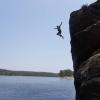- 0
PTSD: Virtual Reality Therapy Part Two: Condemnation
-
Similar Topics
-
- 11 replies
- 3,158 views
-
- 35 replies
- 5,982 views
-
Queensland: STOP Cannabis Arrests and Prosecutions Now 1 2
By MongyMan,
- cannabis
- queensland
- (and 2 more)
- 18 replies
- 12,126 views
-
- 1 answer
- 1,305 views
-





Question
grace
PTSD: Virtual Reality Therapy Part Two: Condemnation
Dr. Phil Leveque Salem-News.com
6 November 2008
http://www.salem-news.com/articles/novembe...que_11-6-08.php
Phillip Leveque has spent his life as a Combat Infantryman, Physician Pharmacologist and Toxicologist.
(MOLALLA, Ore.) - I previously in posted Part One that as a PTSD victim, observer in battle of this, and a physician taking care of over 400 PTSD Vet victims, that I felt that Virtual Reality Therapy (VRT) would not work for the most seriously affected PTSD Vet victims although it might for minimally or moderately affected victims.
As a physician taking care of these patients after they have given up and absolutely rejected VA treatment I have accepted what these VA "rejects" have told me. These Vets have told me of the excessive variety and amount of medications tried on them as human "guinea pigs" which usually made them worse from the adverse side effects. Even newspapers and TV news have indicated about one thousand Vet suicides per month from VA medical malpractice.
The concept that Virtual Reality Therapy for PTSD probably has some value for minimally affected victims but for severe "rubber room" victims it certainly has no place. These are the most needful patients. It appears that the success with minimally affected Vets has given the psychology therapists the psychological chutzpah to assume that VRT would work for the most seriously affected PTSD victims.
Whether these psychologists have been able to back and forth "talk" with extremely serious PTSD victims in the 7-8-9-10 category, I doubt it. They are so bad they can't even endure seeing the word PTSD.
I was astonished to see on my computer 43 pages of stories indicating the great promise of VRT (did they have good Public Relations personnel?). Ok, Ill accept that for the minimally affected Vets.
I also looked up Vets comments on VA pharmaceutical therapy which rarely had an even slightly warm comment. Some of the comments about the psychoneurotic wards in Walter Reed Hospital made me cringe in disbelief. The rest appear not much better.
I know from my own experience as a Combat Infantryman in World War II that alcoholic or nicotine use for temporary escapes from battle were what helped keep us going. I have known about cannabis/marijuana as similar medicine for about 60 years.
When my 400 or so Vietnam Vets told me that cannabis gave better relief than Army medications or beer or booze, I paid attention. Some will say to use Marinol which is pure THC and legal medicine. However it's not the same as the natural substance and produces a large amount of "panic attacks" and paranoia in the 10mg dose.. It is used orally and once it is absorbed, panic attacks can continue for several hours. Inhaled vapors (NOT SMOKE) can be easily adjusted to effective dosage.
Now, Nov 5, 2008, Michigan has become the 13th state approving/allowing medical cannabis/marijuana. We are approaching one million legal medical cannabis users. With the U.S. Govt saying some 70 million use it illegally (for medical purposes).
It is time for the U.S. Govt. employees to get over their REEFER MADNESS and regard cannabis/marijuana as the very useful/successful medicine that it is.
In the meantime millions of Vets and their families are suffering. PTSD is the worst sequel of battle and the VA is "supposed" to be taking care of us. WHAT A DISGRACE.
Part One in this series is available here: PTSD Virtual Reality Therapy: Fraudulent High-Priced Boondoggle: Part
Link to comment
Share on other sites
1 answer to this question
Recommended Posts
Join the conversation
You can post now and register later. If you have an account, sign in now to post with your account.
Note: Your post will require moderator approval before it will be visible.